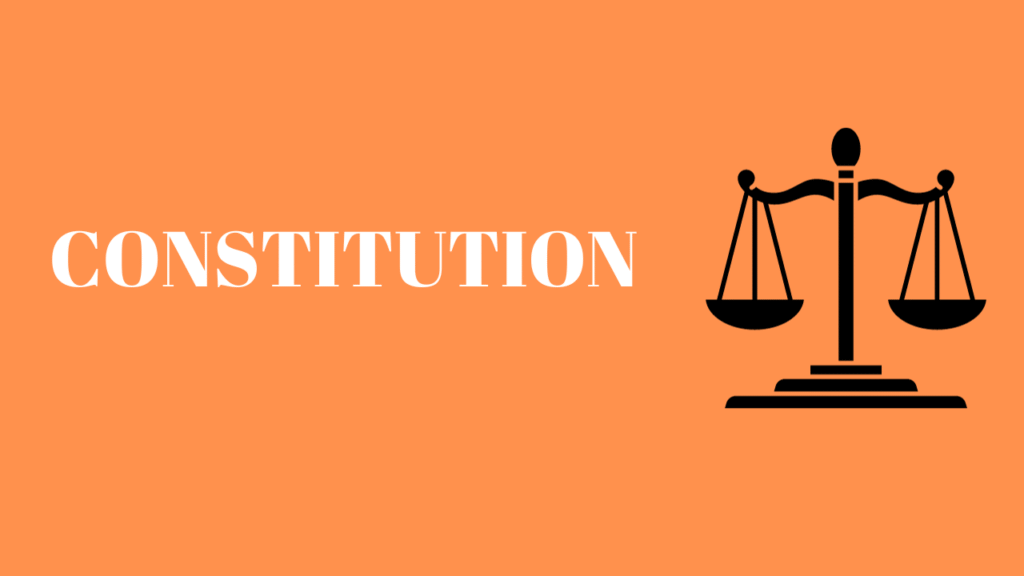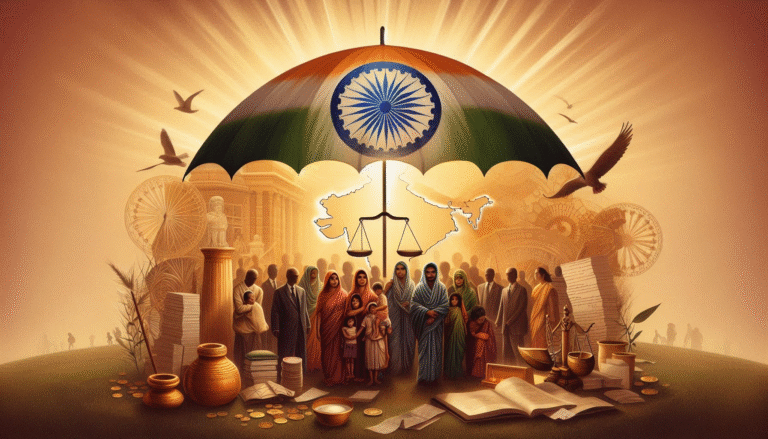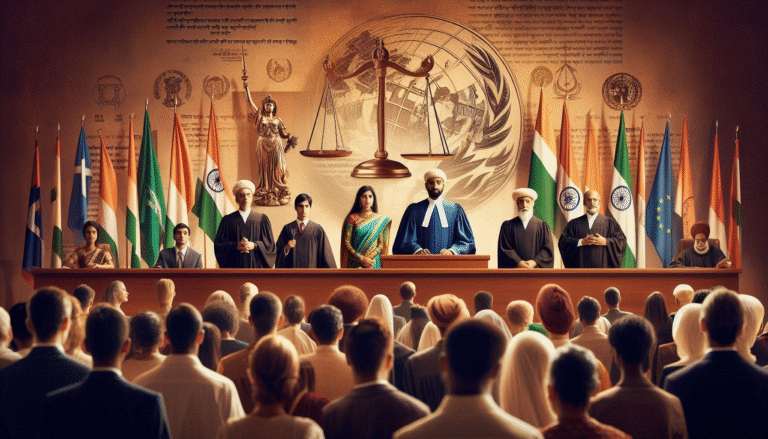
This article is written by author Srijani Shah and is co-authored by Kaustabh Mondal.
Abstract
This research paper explores transformative constitutionalism as a robust legal paradigm, contending that constitutions are dominant tools for social change rather than just being static frameworks. The paper examines how India’s pioneering experiences and equivalent insights from worldwide, particularly through robust judicial interpretation, has fundamentally shaped the jurisprudence of human rights. The Indian judiciary has time and again employed concepts like the “Basic Structure”, along with liberal interpretations of the “Right to Life” (Article 21) eliminated historical inequities and advanced socio-economic justice, fulfilling the transformative goals of the framers of the Constitution thus making the country’s constitutional journey an appealing deposition. Beyond India, the paper focuses on similar routes opted by countries like Colombia, with its innovative ‘Tutela’ action and South Africa, where the constitution has clearly mandated social change as well as authorized the direct enforceability of socio-economic privileges.
It also focuses on Germany’s Basic Law approach which is mostly centered around the lines of dignity. Furthermore, it aims to illustrate how domestic courts frequently draw upon international norms for interpretive guidance, while landmark national judgments contribute to the global evolution of human rights law thus focusing on the symbiotic relationship between national and international human rights jurisprudence. Finally, the paper addresses critical challenges inherent in transformative constitutionalism while asserting that human rights act not just as a legal norm but as a dynamic principle driving democratic renewal and social justice. Ultimately, by examining these aspects, this paper aims to contend that transformative constitutionalism, through its evolving human rights jurisprudence, remains a pivotal agency for building more just and equitable societies.
Keywords: Transformative Constitutionalism, Jurisprudence, Human Rights, Dignity, Social Justice.
Introduction
“The purpose of having a constitution is to transform the society’’ for the better and this objective is fundamental pillar of transformative constitutionalism – Justice Dipak Misra.1
A constitution is a living biological document that embodies the people’s rights and liabilities.
The creation of a constitution is mostly considered a pivotal point in a country’s history, more significant for countries that have gone through a period of colonization that has drained its resources and affected its culture.2 Particularly in those nations the constitution reflects the ambitions of the country to bring about a change in the current order of things.
Transformative constitutionalism refers to a dynamic approach to the interpretation of the constitution that tries to use the constitution as a machinery to significant societal change. This is done by instilling principles like equality, liberty, fraternity and dignity into society that helps address historical injustices, inequalities, and power imbalances in society.
Transformative constitutionalism, as a concept typically arises in post-conflict or transitional societies where constitutions are drafted to mark a break from repressive regimes. For example, it is mostly visible in nations emerging from problems like apartheid (South Africa), colonialism (India), or dictatorship (Germany), where the constitution serves as a vehicle for radical social change through legal means, without relying on violent measures. In nations facing such repression, the constitution is seen as an aspirational document that is committed to ongoing transformation rather than preserving the status quo. This includes promoting substantive equality, social and economic rights, and a culture of justification where legislature and executive actions must align with the constitutional lines.
In India, transformative constitutionalism is embodied in the Indian Constitution of 1950, which was crafted post-independence to dismantle colonial legacies and caste-based inequalities, promoting liberty, equality, and fraternity. In abroad, similar contexts include post-apartheid South Africa, where the constitution explicitly aims to heal racial divisions, and Latin American countries like Colombia and Brazil, where constitutions address socio-economic disparities stemming from authoritarian histories.
This paper on transformative constitutionalism is crucial for various reasons as further explained. Firstly, it provides insights into how constitutions can actively drive democratic transitions and social reforms, especially in divided societies. And by further explanation of this concept in respect to India and abroad, scholars and policymakers can evaluate the effectiveness of judicial interventions and judicial interpretations in realizing constitutional promises of a social welfare state. This research is highly relevant in an era of global challenges like drastic climate change, widening economic disparities, and pluralism. In modern era, transformative constitutionalism can guide the way to achieving elite human rights standards in countries.
Secondly, it highlights the role of judiciary in supporting or hindering transformation and offers lessons on balancing judicial activism with democratic accountability. For example, it underlines the need for endurance and patience in transformative processes, as immediate changes may not always materialize, but long-term structural shifts can occur. In contexts like India, where the judiciary has expanded rights through public interest litigation, research reveals how transformative constitutionalism empowers marginalized groups and enforces socio-economic rights.
In abroad, studies on South Africa and Latin America demonstrate how such researches can inform global models of constitutionalism and warn them against illusions of quick fixes and promote constructive attitude towards court driven changes in society. To sum up, this research fosters a deeper understanding of constitutionalism as a tool for human rights advancement and encourages interdisciplinary approaches that integrate law, history, and sociology to address real-world inequalities.

Philosophical Underpinnings
The philosophical foundations of transformative constitutionalism draw from theories of justice, equality, fraternity and social contract. It emphasizes on the constitution’s role in creating a just society. Rooted in post-liberal thought, it rejects mere containment of state power (as in traditional liberalism) and instead posits the constitution as a mechanism for ongoing societal transformation. The core foundations of this approach derive from John Rawls’ of distributive justice principles and Amartya Sen’s capabilities framework, which focus on achieving actual equality rather than formal equality
Philosophically, it bridges the past and future and it is done by recognizing historical injustices while aspiring to democratic, participatory, and egalitarian futures. It promotes a “culture of justification” where all exercises of power must be rationalized under constitutional norms. India derives its foundation from the combined philosophies of Gandhi and Ambedkar which focuses on human dignity together with fraternity, and complete elimination of caste hierarchies. The concept originates from Ubuntu (human interconnectedness) and anti-apartheid ethics in South Africa and it matches reflexive governance and social rights in Europe. The debate between critics and supporters about judicial overreach exists yet proponents view transformation as an ongoing development which is essential for realizing human potential in unequal societies and views transformation as a continuous process rather than a fixed endpoint.
Inter- linkage between Transformative and Human Rights Jurisprudence
Transformative constitutionalism and human rights jurisprudence overlap significantly in theory and practice, as both aim to protect and expand rights to foster societal change. Theoretically, transformative constitutionalism incorporates human rights as core tools for transformation, viewing rights not just as individual protections but as means to restructure power relations and achieve substantive equality. Human rights jurisprudence, in turn, provides the interpretive framework for courts to enforce these transformations, emphasizing dignity, non-discrimination, and socio-economic rights.
Practically, this overlap manifests in judicial activism where courts expand human rights to address systemic issues. For example, in India, the Supreme Court has used transformative interpretations to decriminalize homosexuality and affirm privacy rights, aligning with global human rights norms. In South Africa, courts enforce socio-economic rights under transformative mandates, overlapping with human rights litigation on housing and health. In Latin America, transformative courts frame issues like violence and inequality as human rights violations, expanding justiciability. Challenges include balancing rights with democratic processes, but the synergy strengthens both fields by making human rights enforceable mechanisms for long-term social justice.
Origin of a Fresh Premise
Transformative constitutionalism evolved primarily from South African jurisprudence in the post-apartheid era. The 1996 South African Constitution was designed as a “bridge” from the oppressive apartheid system to a democratic society based on human dignity, equality, and freedom. Pioneered by scholars like Karl Klare and judges like Pius Langa,3 it emphasized judicial interpretation to actively transform society, addressing economic disparities and racial inequalities.
This evolution marked a shift from conservative legal cultures to progressive ones, where courts fill legislative gaps and enforce rights expansively. Key cases, such as those on socio-economic rights, illustrate this, making South Africa the “birthplace” of the concept. Its influence spread globally, inspiring similar approaches in India (e.g., basic structure doctrine) and Latin America, adapting to local contexts while retaining the core idea of constitutions as agents of change.
History of Transformative Constitutionalism
South Africa: The Birthplace
South Africa is broadly regarded as the birthplace of transformative constitutionalism. Before 1994 South Africa was a country where human rights of its citizens were not considered of any importance and the Parliament made laws as per its discretion without considering human dignity and these laws were unchallengeable in a court of law. In 1996 Constitution was drafted in South Africa to dismantle racial segregation, power imbalances and economic inequalities and it came in force in February 1997.4 The Constitution embodied a Bill of Rights that ensured social welfare and socio-economic protection. Various judicial interpretations, such as in housing and health rights cases have driven transformation but still challenges like persistent poverty exists. In the last 20 years, it has evolved from revolutionary ideals to practical jurisprudence that influenced global models while facing critiques on implementation gaps
Latin America
In Latin America, transformative constitutionalism sheds light on historical violence, inequality, and authoritarianism. In Colombia, the Constitution of 1991 empowered the Constitutional Court to engage in activist jurisprudence. It focuses on issues like internal displacement and health as violation of rights that expanded human rights frontiers despite ongoing conflicts.5
In Brazil, the 1988 Constitution, post-military dictatorship, aimed at social transformation through extensive rights provisions. However, mixed outcomes arise from judicial and political tensions, with successes in health rights but challenges in implementation amid authoritarian backsliding.
Germany
Post World War II, Germany’s Basic Law (1949) embodies transformative constitutionalism by rejecting Nazi authoritarianism and establishing a social market economy with strong rights protections.6 The Federal Constitutional Court has interpreted it dynamically, promoting dignity and social rights, influencing European constitutionalism. It focuses on reflexive governance and has adapted to modern issues like climate litigation.
USA, Europe
The USA has time and again introduced transformative elements especially appearing in the post-Civil War amendments and civil rights jurisprudence, such as in the Brown v. Board of Education case which aimed to end racial segregation and discrimination, to address the age-old oppression of the marginalized. However, with the ongoing, recent controversy about reproductive rights and justice, it is often held by critics not to be fully transformative, often prioritizing preservative constitutionalism. In Europe, the discussed ideal of transformative constitutionalism is often manifested in the European Union’s integration process, evolving from economic union to a rights-based polity. Post-communist transitions in Eastern Europe and EU law emphasize socio-economic rights and privileges as well as democratic values though challenges like financial crises continue to test its potential.
Transformative Constitutionalism: The Indian Journey
As discussed earlier, the concept of transformative constitutionalism does not only mean that a Constitution provides for a politico-legal foundation to a nation but it also serves as a dynamic and essential catalyst to well-timed and urgent societal evolution and reform and this idea is the one that reverberates with India deeply as our Constitution was authored, solely keeping in mind the discrimination and oppressive imperialistic histories, the widespread socio-economic and gender inequities as well as the deep seated caste culture. It became very clear to the framers of our Constitution and above all to the chairman of the drafting committee, Dr. B.R. Ambedkar that in order to tackle and uproot the ongoing fears, prejudices and bigotry within the Indian people, the Constitution should itself act as a vehicle of reform. It was thus decided that our Constitution should not be limited to quick freeze the present state of affairs and is to be dynamic and be able to reintroduce and conserve the principles as instated in the Preamble namely,
“…Justice, social, economic and political;
Liberty of thought, expression, belief, faith and worship;
Equality of status and of opportunity and to promote among them all;
Fraternity assuring the dignity of the individual and the unity and integrity of the Nation….”7
The various landmark and more recent judgments like Kesavananda Bharati, Maneka Gandhi, Joseph Shine and Navtej Johar have shown the importance of an integrated and independent Judiciary in enhancing the causes of Transformative Constitutionalism especially taking into account the changing times and socio-economic realities. But in the mean time the Indian experience has also shown us the hardships and difficulties in the path of the much needed transformation: the ongoing friction between principles of the supreme law of the land and the ongoing social state of affairs, the issues of judicial overreach and activism as well as the hurdles of traditions and culture. Thus, the Indian version of Transformative Constitutionalism is still not a done and dusted assignment but instead it is a voyage that is not going to finish in the near future owing to the multifaceted truths of the Indian society.

Transformative Constitutionalism and the Constitution
Some of the most important transformative characters of the Indian Constitution are: the enumeration as well as guarantee of the Fundamental Rights in part III including Right to Equality in Articles 14-18, Right to Freedom in Articles 19-22, Right against Exploitation in Articles 23 and 24, Right to freedom of Religion in Articles 25-28, Cultural and Educational rights in Articles 29 and 30 and the most important Right to Constitutional Remedies in Article 32; the socio-economic guidelines that is the Directive Principles of State Policy in part IV that aim at establishing a welfare state, securing the citizens and acting as guidelines to the policymakers; Rule of law that holds that it is the law which is the supreme, sovereign and not any person and the Constitution has been able to uphold this axiom though Article 14 and through new age mechanisms of Lok Adalats, Public Interest Litigation which holds that no citizen shall be denied access to justice because of their lack of knowledge or monetary support; the Emergency provisions outlined in part XVIII which clearly foresees that during certain extraordinary circumstances the State cannot be managed in the usual, customary manner; unique blend of rigidity and flexibility; the abolition and criminalization of the deep rooted cultural practice of untouchability8 and that of titles9; Reservations in educational institutes and jobs to ensure equality in practice and not just in ideals and most importantly an independent and integrated Judiciary among others and through these features the Constitution framers has always tried to and has been successful, in many instances, to empower and encourage the oppressed people especially the Dalits, minorities- both linguistic and religious, women, children and in recent times the people of vast sexual orientations and LGBTQ+ communities, to breakdown the colonial paradigms and foster and preserve one of the world’s largest budding democracy.
Transformative Constitutionalism and the Judiciary
Transformative Constitutionalism in India has been largely successful due to the judicial organ of the government which helps to preserve the supremacy, sovereignty and pertinence of the Constitution. The judiciary though its proactive role in recent times, through various judgments has been trying to bridge the existing gaps in the system. This practice of the judiciary where the judges go beyond the precedents and mere interpretation of laws is called judicial activism. Various instances of judicial activism in recent times include the following judgments:
- Kesavananda Bharati v. State of Kerala (1973): This judgment settled the ongoing debate on the Parliament’s power to amend the Constitution as well as the scope of judicial review. It also laid down the doctrine of Basic Structure. It was decided that the Parliament did have the power to amend the fundamental rights but the features which constituted the basic structure of the Constitution like the supremacy of the Constitution, Rule of law, Separation of powers, Federalism, Secularism, Sovereignty of the nation as well as its unity and integrity among others cannot be compromised with.10
- National Legal Services Authority (NALSA) v. Union of India (2014): This is one of the most important decisions in the advancement of transformative constitutionalism. It recognized another gender that is the transgender people as the third gender as well as guaranteed their fundamental rights under Articles 14, 15, 19 and 21. The apex court while giving the judgment decided that “The role of the Court is to understand the central purpose and theme of the Constitution for the welfare of the society. Our Constitution, like the law of the society, is a living organism. It is based on a factual and social reality that is constantly changing. Sometimes a change in the law precedes societal change and is even intended to stimulate it. Sometimes, a change in the law is the result of social reality.”11
- Justice K.S Puttaswamy v, Union of India (2018): This judgment recognized the right to privacy under Article 21 as a fundamental right that cannot be suspended even during the proclamation of an emergency but is subject to reasonable restrictions.12
- Navtej Singh Johar v. Union of India (2018): This case was a landmark decision for the
LGBTQ+ community since it decriminalized the much controversial provision of Section 377 of the Indian Penal Code. This section held that “Whoever voluntarily has carnal intercourse against the order of nature with any man, woman or animal, shall be punished with imprisonment for life, or with imprisonment of either description for a term which may extend to ten years, and shall also be liable to fine”, effectively making homosexuality illegal. The decision thus had an impeccable effect on homosexual rights worldwide.13
- Joseph Shine v. Union of India (2018): This landmark judgment decriminalized adultery and made Sections 497 of the IPC and 198(2) of CrPC as unconstitutional. The court decided the abovementioned sections to be arbitrary and thus reinstated the importance of a woman’s bodily emancipation and gender equality.14
- Indian Young Lawyers Association v. State of Kerala (2018): This decision was in favour of the petitioners who filed a public interest litigation against the restriction levied on menstruating women to enter the premises of the Sabarimala temple. Although this judgment is still under review but striking down the unreasonable restriction was a step ahead in the direction of transformative constitutionalism.15
- Anuradha Bhasin v. Union of India (2020): A time when internet was banned and restrictions were laid down on the press and public in Jammu and Kashmir, the apex court declared that such restrictions violate Article 19(1)(a) and (g) of the Constitution in this case.16
Some other landmark cases include the 2017 judgment of Shayara Bano v. Union of India where the practice of instant triple talaq was made unconstitutional; the 1997 judgment of Vishaka v. State of Rajasthan which declared workplace harassment of women to be an offence and thus upheld the fundamental rights of women even in workplaces. Despite the vast opposition it faces from various sections of the society, the Indian experience of transformative constitutionalism shows us the robustness that the Constitution has in being the dynamic supreme law of the land.
Evolving nature of Human rights
During its adoption, the Indian Constitution had initially focused mostly on securing the citizens’ first-generation rights or civil and political rights under part III so as to establish justice, liberty, equality and fraternity. But with ever changing social norms and conditions the demonstration of our Fundamental rights also had to be widened and inflated beyond this status quo. For example, the judiciary has in several instances endorsed transformative constitutionalism by liberal interpretation of Article 21- Right to life and personal liberty to include within it several other rights like right to livelihood (Olga Tellis and Ors.v. Bombay Municipal Corporation), right to health and medical assistance (Pt. Parmanand Katara(Retd.) v. Union of India), right to shelter (Chameli Singh v. State of U.P), right to reputation (Subramanian Swamy v. Union of India), right to basic education (Unni Krishnan v. State of Andhra Pradesh) and others. This elucidation had also been enlarged to include environmental rights as seen in the MC Mehta chain of judgments, establishing the polluter pays and precautionary principles as well as reinstating sustainable development as one of the primary aims of the country. The evolution of rights in India thus now extends to various third generation rights amongst the fast-paced growth of urbanization and industrialization and ecological imbalances ensuing from the same. This movement shows a gradual shift towards positive socio-economic liberties from negative restrictions on the arbitrary actions of the State.
Such evolution of human rights forms the basis of transformative constitutionalism, which also has an effect and in turn is affected by the global standards. India has, for instance, endorsed the International Covenant on Civil and Political Rights (ICCPR) and the International Covenant on Economic, Social and Cultural Rights (ICESCR), thus sanctioning the significance of both civil- political (freedom of expression, religion, fair trial among others) and socio-economic liberties (right to education, employment, basic standard of living and social security). The domestic implementation of these rights by our Judiciary is now increasingly dependent on international conventions like these which acts as an instrument for harmonizing national norms to global standards, a commitment more prominent in Article 51(c) of the Constitution. In the famous case of People’s Union for Civil Liberties v. Union of India, the apex court in instances had relied on Article 11 of the International Covenant on Economic, Social and Cultural Rights (ICESCR) in order to elucidate the essential measures for ensuring safety standards of food.17 In Vishakha v. State of Rajasthan where the apex court while laying down the norms to be followed in cases of sexual harassment at workplaces, it relied largely on the Convention on the Elimination of All Forms of Discrimination Against Women (CEDAW) while again in NALSA v. Union of India, the court invoked both the provisions of ICCPR as well as the Yogyakarta principles.
Above all the Indian judiciary has employed transformative constitutionalism to uphold the dignity of various groups of marginalized communities. In order to address the gender disparities, the apex court has questioned age old customs in cases like Indian Young Lawyers Association v. State of Kerala and Shayara Bano v. Union of India. For addressing caste inequities, amidst the highly grossing debates and tensions, courts on numerous circumstances had encouraged affirmative actions through provisions of reservations on the basis of caste as well as economic position such as in the State of Madras v. Champakam Dorairajan, Indra Sawhney v. Union of India and the M.Nagaraj v. Union of India decision which even introduced reservations in the case of promotions; all for the upliftment of those who had been discriminated against since time immemorial. The rights of indigenous people has also been secured through decisions like Samatha v. State of Andhra Pradesh, which has been successful in protecting tribal lands from their encroachment and illegal use by people outside the natural members of the inhabiting tribes; disabled people have also been saved form inequities in air travel as elucidated in Jeeja Ghosh v. Union of India. Moreover, in cases concerning the privileges and liberties of convicts, the Indian courts has upheld their human rights as confirmed in cases like State of A.P. v. Challa Ramkrishna Reddy. Even though they are devoid of some liberties owing to the imprisonment but they still continue to be humans and possess basic rights to life and dignity, to legal aid, speedy and fair trial, protection against solitary confinement and arbitrary, excessive and inhumane treatment.

Critical challenges: Where to set the boundary?
The Indian take on transformative constitutionalism has proven to be one of the sole carriers of the evolution of human rights in not only India but also has has an effect worldwide. But the prime hurdles remain undermining its positive effects. Such challenges involve the heated debate between judicial overreach and activism. Although judicial activism, through instruments of PILs and Lok adalats, has been much enduring a tool in enhancing the causes of socio- economic justice but the constitutional experts have time and again warned sternly of plausible overreach. It is when the independent and integrated judicial organ threatens to go beyond its jurisdiction laid down by the Constitution, thus interfering with the normal functioning of the other two organs- legislative and executive. Such interference, mostly warned in cases of contempt of court, can result in unwanted friction among the three organs of the government, undermining the constitutionally mandated principle of separation of powers.
Moreover, the practice of transformative constitutionalism encompasses the compulsory upliftment of constitutionally mandated principles of justice, equality, human dignity, irrespective of their effect and friction with the popular opinion. Courts tend to separate the popular will from constitutional mandates, though it is the will of the people itself from where not only the government but also the supreme law of the land derives its legality. For instance, the decisions made in the 2018 Sabarimala case allowing the entry of women of all ages in the temple and the Navtej Johar case, decriminalizing homosexuality under Section 377, faced widespread backlash, particularly for hurting religious and cultural sentiments of the people. Thus, such protests show the importance of popular morality in guiding the process and standards of transformative constitutionalism in the State.
Additionally, political agents, in order to garner vote banks for their political gain try to adulterate the process of societal reforms. Legislative backlogs, abrupt amendments violating judicial pronouncements, red tapism, corruption in the bureaucracy are other hurdles posed politically in the trajectory of transformative constitutionalism. In order to establish harmony in such crisis, persistent mediation and conciliation is essential among judicial intent, constitutional mandates and socio- politico will.
Recommendations and Conclusion
India’s journey of transformative constitutionalism is not an easy one. The contemporary experiences of other nations can be beneficial in this journey. India must try and initiate cross border discourse, especially with South Africa, countries of Latin America, USA and Europe. Such dialogues will enhance not only civil rights but also socio- economic rights. India can take guidelines on the Judiciary’s role in implementation of the orders given and the monitoring of the same. Moreover, such connections can help us to understand the prowess of institutions like the National and State Human Rights Commission, Law Commissions and others.
Mobilizing the power of social media in voicing popular morality and how such popular opinion plays an important part in major and minor law – making decisions must also be understood. Social media can be made to spread awareness among the people about their rights and liberties and the effects of landmark judgments on them. At the same time, spread of false information is something which needs to be seriously and rapidly regulated. Awareness campaigns in both rural and urban settings, digital literacy campaigns, encompassing such education within the academic curricula, taking into account other stakeholders like the youth of the nation, the nongovernmental bodies, constitutional and popular mandate experts, judicial officers, grassroots’ involvement among others must be strengthened. These measures, if implemented well, can prove to be influential in bridging the existing breaches between societal reality and aspirations. Lastly, we can conclude by asserting that the ideal of Transformative constitutionalism is still not an accomplished project but is instead an ongoing, dynamic assignment. Although India through the three organs of the government and their smooth interaction, has been successful in advancing the constitutional ideals of justice, liberty, equality and fraternity, its inter- linkage and exchange of comparative perspectives from all over the world outline the necessity of counteracting judicial activism with popular mandate and institutional transparency for advancing the causes of transformative constitutionalism. The actual scrutiny of transformative constitutionalism lies in fostering a balanced approach to address the complex challenges and to identify how legal advocacy and the collaboration among courts, people and the civil society is necessary in this approach.
Footnotes
- Dharmesh, An analysis of transformative constitutionalism in India and the role played by the judiciary in shaping the constitution, 5 Int’l J. L., Pol’y & Soc. Rev. 129, 129 (2023). ↩︎
- Srishti Patwal, Transformative Constitutionalism, 2 Indian J. Integrated Res. L. 1 (2022). ↩︎
- Mashele Rapatsa, Transformative Constitutionalism in South Africa: 20 Years of Democracy, 5 Mediterr. J. Soc. Sci. 887 (2014) ↩︎
- Marta Teshome, Transformative Constitutionalism in South Africa (Jan. 2011), available at ResearchGate, https://www.researchgate.net/publication/260460449 ↩︎
- María-Dolores Collazos, “Social Transformation in Colombia: Internally Displaced Persons and the Constitutional Court – A Landmark Case,” IACL-AIDC Blog (July 21, 2020), https://blog-iacl-aidc.org/constitutional-landmarkjudgments-in-central-and-south-america/2020/7/21/vxl7y4pwj6ugz4prke6fcbg3oerm15 ↩︎
- Ulrich R. Haltern, High Time for a Check-Up: Progressivism, Populism, and Constitutional Review in Germany, JMWP, 1996, at 1, 1 (1996). ↩︎
- India Const. pmbl. ↩︎
- India Const. art. 17. ↩︎
- India Const. art. 18. ↩︎
- Kesavananda Bharati v. State of Kerala, (1973) 4 SCC 225 (India). ↩︎
- National Legal Servs. Auth. v. Union of India, (2014) 5 SCC 438 (India). ↩︎
- Justice K.S. Puttaswamy v. Union of India, (2017) 10 SCC 1 (India). ↩︎
- Navtej Singh Johar v. Union of India, (2018) 10 SCC 1 (India). ↩︎
- Joseph Shine v. Union of India, (2019) 3 SCC 39 (India). ↩︎
- Indian Young Lawyers Ass’n v. State of Kerala, (2019) 11 SCC 1 (India). ↩︎
- Anuradha Bhasin v. Union of India, (2020) 3 SCC 637 (India). ↩︎
- Prasoon Shekhar, Human Rights and Constitution of India, iPleaders (Oct. 4, 2020), https://blog.ipleaders.in/human-rights-constitution-india/. ↩︎




